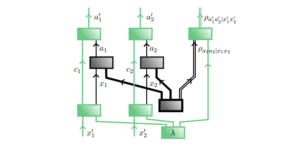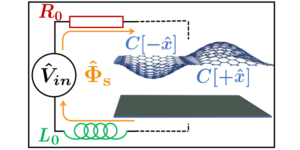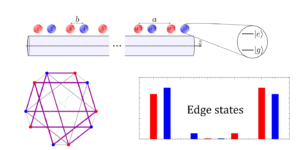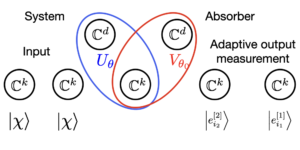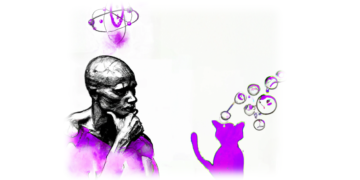1Department of Physics & Astronomy, University of British Columbia, Vancouver, Canada
2Stewart Blusson Quantum Matter Institute, University of British Columbia, Vancouver, Canada
3Department of Mathematics, Bilkent University, Ankara, Turkey
Find this paper interesting or want to discuss? Scite or leave a comment on SciRate.
Abstract
A web of cohomological facts relates quantum error correction, measurement-based quantum computation, symmetry protected topological order and contextuality. Here we extend this web to quantum computation with magic states. In this computational scheme, the negativity of certain quasiprobability functions is an indicator for quantumness. However, when constructing quasiprobability functions to which this statement applies, a marked difference arises between the cases of even and odd local Hilbert space dimension. At a technical level, establishing negativity as an indicator of quantumness in quantum computation with magic states relies on two properties of the Wigner function: their covariance with respect to the Clifford group and positive representation of Pauli measurements. In odd dimension, Gross' Wigner function – an adaptation of the original Wigner function to odd-finite-dimensional Hilbert spaces – possesses these properties. In even dimension, Gross' Wigner function doesn't exist. Here we discuss the broader class of Wigner functions that, like Gross', are obtained from operator bases. We find that such Clifford-covariant Wigner functions do not exist in any even dimension, and furthermore, Pauli measurements cannot be positively represented by them in any even dimension whenever the number of qudits is n$geq$2. We establish that the obstructions to the existence of such Wigner functions are cohomological.
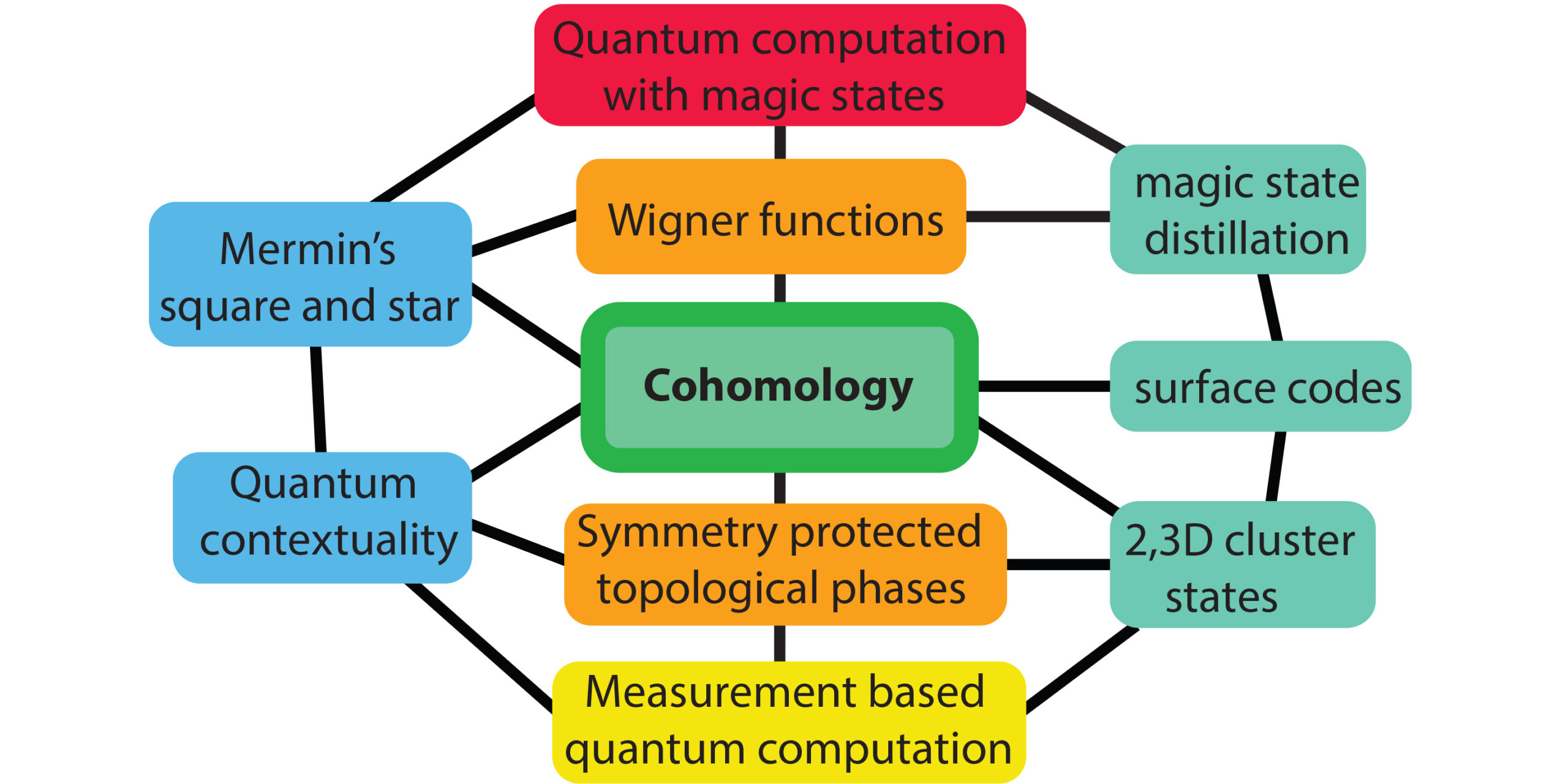
Featured image: Web of constructs in quantum computation and quantum physics that relate to cohomology.
Popular summary
In the scheme of quantum computation with magic states, it has been established that a quantum speedup can arise only if a quasiprobability function representing the initial state takes negative values. However, not all quasiprobability functions can serve as reliable indicators. When the dimension of the Hilbert space is odd, Gross' Wigner function can be used for this purpose. In contrast, when the dimension is even, Gross' Wigner function doesn't exist, and the process of constructing an appropriate indicator becomes more involved. In this work, we identify a mathematical reason for this dichotomy: cohomological obstructions occur in the even-dimensional case, but not in the odd-dimensional case.
► BibTeX data
► References
[1] Mikio Nakahara. ``Geometry, topology and physics''. Taylor & Francis. (1990). doi: 10.1201/9781315275826.
https://doi.org/10.1201/9781315275826
[2] Simon Kochen and E. P. Specker. ``The problem of hidden variables in quantum mechanics''. Journal of Mathematics and Mechanics 17, 59–87 (1967). doi: 10.1512/iumj.1968.17.17004.
https://doi.org/10.1512/iumj.1968.17.17004
[3] Samson Abramsky and Adam Brandenburger. ``The sheaf-theoretic structure of non-locality and contextuality''. New Journal of Physics 13, 113036 (2011). doi: 10.1088/1367-2630/13/11/113036. arXiv:1102.0264.
https://doi.org/10.1088/1367-2630/13/11/113036
arXiv:1102.0264
[4] Samson Abramsky, Shane Mansfield, and Rui Soares Barbosa. ``The cohomology of non-locality and contextuality''. Electronic Proceedings in Theoretical Computer Science 95, 1–14 (2012). doi: 10.4204/eptcs.95.1. arXiv:1111.3620.
https://doi.org/10.4204/eptcs.95.1
arXiv:1111.3620
[5] Cihan Okay, Sam Roberts, Stephen D. Bartlett, and Robert Raussendorf. ``Topological proofs of contextuality in quantum mechanics''. Quantum Information and Computation 17, 1135–1166 (2017). doi: 10.26421/QIC17.13-14-5. arXiv:1701.01888.
https://doi.org/10.26421/QIC17.13-14-5
arXiv:1701.01888
[6] Anatole Kenfack and Karol Zyczkowski. ``Negativity of the wigner function as an indicator of non-classicality''. Journal of Optics B: Quantum and Semiclassical Optics 6, 396–404 (2004). doi: 10.1088/1464-4266/6/10/003. arXiv:quant-ph/0406015.
https://doi.org/10.1088/1464-4266/6/10/003
arXiv:quant-ph/0406015
[7] Robert W. Spekkens. ``Negativity and contextuality are equivalent notions of nonclassicality''. Physical Review Letters 101, 020401 (2008). doi: 10.1103/PhysRevLett.101.020401. arXiv:0710.5549.
https://doi.org/10.1103/PhysRevLett.101.020401
arXiv:0710.5549
[8] Nicolas Delfosse, Cihan Okay, Juan Bermejo-Vega, Dan E Browne, and Robert Raussendorf. ``Equivalence between contextuality and negativity of the wigner function for qudits''. New Journal of Physics 19, 123024 (2017). doi: 10.1088/1367-2630/aa8fe3. arXiv:1610.07093.
https://doi.org/10.1088/1367-2630/aa8fe3
arXiv:1610.07093
[9] Jonas Haferkamp and Juani Bermejo-Vega. ``Equivalence of contextuality and wigner function negativity in continuous-variable quantum optics'' (2021) arXiv:2112.14788.
arXiv:2112.14788
[10] Robert I. Booth, Ulysse Chabaud, and Pierre-Emmanuel Emeriau. ``Contextuality and wigner negativity are equivalent for continuous-variable quantum measurements''. Physical Review Letters 129, 230401 (2022). doi: 10.1103/PhysRevLett.129.230401. arXiv:2111.13218.
https://doi.org/10.1103/PhysRevLett.129.230401
arXiv:2111.13218
[11] Ernesto F. Galvao. ``Discrete wigner functions and quantum computational speedup''. Physical Review A 71, 042302 (2005). doi: 10.1103/PhysRevA.71.042302. arXiv:quant-ph/0405070.
https://doi.org/10.1103/PhysRevA.71.042302
arXiv:quant-ph/0405070
[12] Cecilia Cormick, Ernesto F. Galvão, Daniel Gottesman, Juan Pablo Paz, and Arthur O. Pittenger. ``Classicality in discrete wigner functions''. Phyical Review A 73, 012301 (2006). doi: 10.1103/PhysRevA.73.012301. arXiv:quant-ph/0506222.
https://doi.org/10.1103/PhysRevA.73.012301
arXiv:quant-ph/0506222
[13] Mark Howard, Joel Wallman, Victor Veitch, and Joseph Emerson. ``Contextuality supplies the `magic' for quantum computation''. Nature 510, 351–355 (2014). doi: 10.1038/nature13460. arXiv:1401.4174.
https://doi.org/10.1038/nature13460
arXiv:1401.4174
[14] Mark Howard, Eoin Brennan, and Jiri Vala. ``Quantum contextuality with stabilizer states''. Entropy 15, 2340–2362 (2013). doi: 10.3390/e15062340. arXiv:1501.04342.
https://doi.org/10.3390/e15062340
arXiv:1501.04342
[15] Victor Veitch, Christopher Ferrie, David Gross, and Joseph Emerson. ``Negative quasi-probability as a resource for quantum computation''. New Journal of Physics 14, 113011 (2012). doi: 10.1088/1367-2630/14/11/113011. arXiv:1201.1256.
https://doi.org/10.1088/1367-2630/14/11/113011
arXiv:1201.1256
[16] A. Yu. Kitaev. ``Fault-tolerant quantum computation by anyons''. Annals of Physics 303, 2–30 (2003). doi: 10.1016/S0003-4916(02)00018-0. arXiv:quant-ph/9707021.
https://doi.org/10.1016/S0003-4916(02)00018-0
arXiv:quant-ph/9707021
[17] Eric Dennis, Alexei Kitaev, Andrew Landahl, and John Preskill. ``Topological quantum memory''. Journal of Mathethematical Physics 43, 4452–4505 (2002). doi: 10.1063/1.1499754. arXiv:quant-ph/0110143.
https://doi.org/10.1063/1.1499754
arXiv:quant-ph/0110143
[18] R. Raussendorf, J. Harrington, and K. Goyal. ``A fault-tolerant one-way quantum computer''. Annals of Physics 321, 2242–2270 (2006). doi: 10.1016/j.aop.2006.01.012. arXiv:quant-ph/0510135.
https://doi.org/10.1016/j.aop.2006.01.012
arXiv:quant-ph/0510135
[19] N. David Mermin. ``Hidden variables and the two theorems of john bell''. Reviews of Modern Physics 65, 803–815 (1993). doi: 10.1103/RevModPhys.65.803. arXiv:1802.10119.
https://doi.org/10.1103/RevModPhys.65.803
arXiv:1802.10119
[20] Robert Raussendorf and Hans J. Briegel. ``A one-way quantum computer''. Physical Review Letters 86, 5188–5191 (2001). doi: 10.1103/PhysRevLett.86.5188.
https://doi.org/10.1103/PhysRevLett.86.5188
[21] Robert Raussendorf. ``Contextuality in measurement-based quantum computation''. Physical Review A 88, 022322 (2013). doi: 10.1103/PhysRevA.88.022322. arXiv:0907.5449.
https://doi.org/10.1103/PhysRevA.88.022322
arXiv:0907.5449
[22] Robert Raussendorf. ``Cohomological framework for contextual quantum computations''. Quantum Information and Computation 19, 1141–1170 (2019). doi: 10.26421/QIC19.13-14-4. arXiv:1602.04155.
https://doi.org/10.26421/QIC19.13-14-4
arXiv:1602.04155
[23] Akimasa Miyake. ``Quantum computation on the edge of a symmetry-protected topological order''. Physical Review Letters 105, 040501 (2010). doi: 10.1103/PhysRevLett.105.040501. arXiv:1003.4662.
https://doi.org/10.1103/PhysRevLett.105.040501
arXiv:1003.4662
[24] Dominic V. Else, Ilai Schwarz, Stephen D. Bartlett, and Andrew C. Doherty. ``Symmetry-protected phases for measurement-based quantum computation''. Physical Review Letters 108, 240505 (2012). doi: 10.1103/PhysRevLett.108.240505. arXiv:1201.4877.
https://doi.org/10.1103/PhysRevLett.108.240505
arXiv:1201.4877
[25] Jacob Miller and Akimasa Miyake. ``Resource quality of a symmetry-protected topologically ordered phase for quantum computation''. Physical Review Letters 114, 120506 (2015). doi: 10.1103/PhysRevLett.114.120506. arXiv:1409.6242.
https://doi.org/10.1103/PhysRevLett.114.120506
arXiv:1409.6242
[26] Robert Raussendorf, Dong-Sheng Wang, Abhishodh Prakash, Tzu-Chieh Wei, and David T. Stephen. ``Symmetry-protected topological phases with uniform computational power in one dimension''. Physical Review A 96, 012302 (2017). doi: 10.1103/PhysRevA.96.012302. arXiv:1609.07549.
https://doi.org/10.1103/PhysRevA.96.012302
arXiv:1609.07549
[27] Robert Raussendorf, Cihan Okay, Dong-Sheng Wang, David T. Stephen, and Hendrik Poulsen Nautrup. ``Computationally universal phase of quantum matter''. Physical Review Letters 122, 090501 (2019). doi: 10.1103/PhysRevLett.122.090501. arXiv:1803.00095.
https://doi.org/10.1103/PhysRevLett.122.090501
arXiv:1803.00095
[28] David T. Stephen, Hendrik Poulsen Nautrup, Juani Bermejo-Vega, Jens Eisert, and Robert Raussendorf. ``Subsystem symmetries, quantum cellular automata, and computational phases of quantum matter''. Quantum 3, 142 (2019). doi: 10.22331/q-2019-05-20-142. arXiv:1806.08780.
https://doi.org/10.22331/q-2019-05-20-142
arXiv:1806.08780
[29] Trithep Devakul and Dominic J. Williamson. ``Universal quantum computation using fractal symmetry-protected cluster phases''. Physical Review A 98, 022332 (2018). doi: 10.1103/PhysRevA.98.022332. arXiv:1806.04663.
https://doi.org/10.1103/PhysRevA.98.022332
arXiv:1806.04663
[30] Austin K. Daniel, Rafael N. Alexander, and Akimasa Miyake. ``Computational universality of symmetry-protected topologically ordered cluster phases on 2D Archimedean lattices''. Quantum 4, 228 (2020). doi: 10.22331/q-2020-02-10-228. arXiv:1907.13279.
https://doi.org/10.22331/q-2020-02-10-228
arXiv:1907.13279
[31] Austin K. Daniel and Akimasa Miyake. ``Quantum computational advantage with string order parameters of one-dimensional symmetry-protected topological order''. Physical Review Letters 126, 090505 (2021). doi: 10.1103/PhysRevLett.126.090505. arXiv:2007.16160.
https://doi.org/10.1103/PhysRevLett.126.090505
arXiv:2007.16160
[32] Sergey Bravyi and Alexei Kitaev. ``Universal quantum computation with ideal clifford gates and noisy ancillas''. Physical Review A 71, 022316 (2005). doi: 10.1103/PhysRevA.71.022316. arXiv:quant-ph/0403025.
https://doi.org/10.1103/PhysRevA.71.022316
arXiv:quant-ph/0403025
[33] Eugene Wigner. ``On the quantum correction for thermodynamic equilibrium''. Physical Review 40, 749–759 (1932). doi: 10.1103/PhysRev.40.749.
https://doi.org/10.1103/PhysRev.40.749
[34] Kathleen S. Gibbons, Matthew J. Hoffman, and William K. Wootters. ``Discrete phase space based on finite fields''. Physical Review A 70, 062101 (2004). doi: 10.1103/PhysRevA.70.062101. arXiv:quant-ph/0401155.
https://doi.org/10.1103/PhysRevA.70.062101
arXiv:quant-ph/0401155
[35] A. Mari and J. Eisert. ``Positive wigner functions render classical simulation of quantum computation efficient''. Physical Review Letters 109, 230503 (2012). doi: 10.1103/PhysRevLett.109.230503. arXiv:1208.3660.
https://doi.org/10.1103/PhysRevLett.109.230503
arXiv:1208.3660
[36] David Gross. ``Computational power of quantum many-body states and some results on discrete phase spaces''. Phd thesis. Institute for Mathematical Sciences, Imperial College London. (2008). url: https://www.thp.uni-koeln.de/gross/files/diss.pdf.
https://www.thp.uni-koeln.de/gross/files/diss.pdf
[37] David Gross. ``Hudson’s theorem for finite-dimensional quantum systems''. Journal of Mathematical Physics 47, 122107 (2006). doi: 10.1063/1.2393152. arXiv:quant-ph/0602001.
https://doi.org/10.1063/1.2393152
arXiv:quant-ph/0602001
[38] Hakop Pashayan, Joel J. Wallman, and Stephen D. Bartlett. ``Estimating outcome probabilities of quantum circuits using quasiprobabilities''. Physical Review Letters 115 (2015). doi: 10.1103/physrevlett.115.070501. arXiv:1503.07525.
https://doi.org/10.1103/physrevlett.115.070501
arXiv:1503.07525
[39] Lucas Kocia and Peter Love. ``Discrete wigner formalism for qubits and noncontextuality of clifford gates on qubit stabilizer states''. Physical Review A 96, 062134 (2017). doi: 10.1103/PhysRevA.96.062134. arXiv:1705.08869.
https://doi.org/10.1103/PhysRevA.96.062134
arXiv:1705.08869
[40] Nicolas Delfosse, Philippe Allard Guerin, Jacob Bian, and Robert Raussendorf. ``Wigner function negativity and contextuality in quantum computation on rebits''. Physical Review X 5, 021003 (2015). doi: 10.1103/PhysRevX.5.021003. arXiv:1409.5170.
https://doi.org/10.1103/PhysRevX.5.021003
arXiv:1409.5170
[41] Robert Raussendorf, Dan E. Browne, Nicolas Delfosse, Cihan Okay, and Juan Bermejo-Vega. ``Contextuality and wigner-function negativity in qubit quantum computation''. Physical Review A 95, 052334 (2017). doi: 10.1103/physreva.95.052334. arXiv:1511.08506.
https://doi.org/10.1103/physreva.95.052334
arXiv:1511.08506
[42] Robert Raussendorf, Juani Bermejo-Vega, Emily Tyhurst, Cihan Okay, and Michael Zurel. ``Phase-space-simulation method for quantum computation with magic states on qubits''. Physical Review A 101, 012350 (2020). doi: 10.1103/PhysRevA.101.012350. arXiv:1905.05374.
https://doi.org/10.1103/PhysRevA.101.012350
arXiv:1905.05374
[43] Huangjun Zhu. ``Permutation symmetry determines the discrete wigner function''. Physical Review Letters 116, 040501 (2016). doi: 10.1103/PhysRevLett.116.040501. arXiv:1504.03773.
https://doi.org/10.1103/PhysRevLett.116.040501
arXiv:1504.03773
[44] Mark Howard and Earl Campbell. ``Application of a resource theory for magic states to fault-tolerant quantum computing''. Physical Review Letters 118 (2017). doi: 10.1103/physrevlett.118.090501. arXiv:1609.07488.
https://doi.org/10.1103/physrevlett.118.090501
arXiv:1609.07488
[45] William M. Kirby and Peter J. Love. ``Contextuality test of the nonclassicality of variational quantum eigensolvers''. Physical Review Letters 123 (2019). doi: 10.1103/physrevlett.123.200501. arXiv:1904.02260.
https://doi.org/10.1103/physrevlett.123.200501
arXiv:1904.02260
[46] David Schmid, Haoxing Du, John H. Selby, and Matthew F. Pusey. ``Uniqueness of noncontextual models for stabilizer subtheories''. Physical Review Letters 129, 120403 (2022). doi: 10.1103/PhysRevLett.129.120403. arXiv:2101.06263.
https://doi.org/10.1103/PhysRevLett.129.120403
arXiv:2101.06263
[47] Arne Heimendahl. ``The stabilizer polytope and contextuality for qubit systems''. Master's thesis. University of Cologne. (2019). url: http://www.mi.uni-koeln.de/opt/wp-content/uploads/2020/07/MT_Arne_Heimendahl.pdf.
http://www.mi.uni-koeln.de/opt/wp-content/uploads/2020/07/MT_Arne_Heimendahl.pdf
[48] Michael Zurel, Cihan Okay, and Robert Raussendorf. ``Hidden variable model for universal quantum computation with magic states on qubits''. Physical Review Letters 125, 260404 (2020). doi: 10.1103/PhysRevLett.125.260404. arXiv:2004.01992.
https://doi.org/10.1103/PhysRevLett.125.260404
arXiv:2004.01992
[49] R. L. Stratonovich. ``On distributions in representation space''. Zhurnal Éksperimental'noĭ i Teoreticheskoĭ Fiziki 31, 1012–1020 (1956). url: http://jetp.ras.ru/cgi-bin/dn/e_004_06_0891.pdf.
http://jetp.ras.ru/cgi-bin/dn/e_004_06_0891.pdf
[50] C. Brif and A. Mann. ``A general theory of phase-space quasiprobability distributions''. Journal of Physics A: Mathematical and General 31, L9–L17 (1998). doi: 10.1088/0305-4470/31/1/002. arXiv:quant-ph/9707010.
https://doi.org/10.1088/0305-4470/31/1/002
arXiv:quant-ph/9707010
[51] Daniel Gottesman. ``The heisenberg representation of quantum computers''. In S. P. Corney, R. Delbourgo, and P. D. Jarvis, editors, Proceedings of the XXII International Colloquium on Group Theoretical Methods in Physics. Pages 32–43. (1999). arXiv:quant-ph/9807006.
arXiv:quant-ph/9807006
[52] Scott Aaronson and Daniel Gottesman. ``Improved simulation of stabilizer circuits''. Physical Review A 70, 052328 (2004). doi: 10.1103/PhysRevA.70.052328. arXiv:quant-ph/0406196.
https://doi.org/10.1103/PhysRevA.70.052328
arXiv:quant-ph/0406196
[53] A. Chi-Chih Yao. ``Quantum circuit complexity''. In Proceedings of 1993 IEEE 34th Annual Foundations of Computer Science. Pages 352–361. (1993). doi: 10.1109/SFCS.1993.366852.
https://doi.org/10.1109/SFCS.1993.366852
[54] Michael A. Nielsen and Isaac L. Chuang. ``Quantum computation and quantum information''. Cambridge University Press. (2000). doi: 10.1017/CBO9780511976667.
https://doi.org/10.1017/CBO9780511976667
[55] Sergey Bravyi, Graeme Smith, and John A. Smolin. ``Trading classical and quantum computational resources''. Physical Review X 6, 021043 (2016). doi: 10.1103/PhysRevX.6.021043. arXiv:1506.01396.
https://doi.org/10.1103/PhysRevX.6.021043
arXiv:1506.01396
[56] R.L. Hudson. ``When is the wigner quasi-probability density non-negative?''. Reports on Mathematical Physics 6, 249–252 (1974). doi: 10.1016/0034-4877(74)90007-X.
https://doi.org/10.1016/0034-4877(74)90007-X
[57] Christopher Ferrie. ``Quasi-probability representations of quantum theory with applications to quantum information science''. Reports on Progress in Physics 74, 116001 (2011). doi: 10.1088/0034-4885/74/11/116001. arXiv:1010.2701.
https://doi.org/10.1088/0034-4885/74/11/116001
arXiv:1010.2701
[58] Michael Zurel. ``Hidden variable models and classical simulation algorithms for quantum computation with magic states on qubits''. Master's thesis. University of British Columbia. (2020). doi: 10.14288/1.0394790.
https://doi.org/10.14288/1.0394790
[59] Lucas Kocia and Peter Love. ``The non-disjoint ontic states of the grassmann ontological model, transformation contextuality, and the single qubit stabilizer subtheory''. Journal of Physics A: Mathematical and Theoretical 52, 095303 (2019). doi: 10.1088/1751-8121/aafca7. arXiv:1805.09514.
https://doi.org/10.1088/1751-8121/aafca7
arXiv:1805.09514
[60] Alejandro Adem and R. James Milgram. ``Cohomology of finite groups''. Springer Berlin, Heidelberg. (2013). doi: 10.1007/978-3-662-06280-7.
https://doi.org/10.1007/978-3-662-06280-7
[61] Steven Roman. ``Advanced linear algebra''. Springer New York, NY. (2008). doi: 10.1007/978-0-387-72831-5.
https://doi.org/10.1007/978-0-387-72831-5
[62] David Schmid, John H. Selby, Matthew F. Pusey, and Robert W. Spekkens. ``A structure theorem for generalized-noncontextual ontological models'' (2020) arXiv:2005.07161.
arXiv:2005.07161
[63] Piers Lillystone and Joseph Emerson. ``A contextual $psi$-epistemic model of the $n$-qubit stabilizer formalism'' (2019) arXiv:1904.04268.
arXiv:1904.04268
[64] Michael Zurel, Cihan Okay, Robert Raussendorf, and Arne Heimendahl. ``Hidden variable model for quantum computation with magic states on qudits of any dimension'' (2021) arXiv:2110.12318.
arXiv:2110.12318
[65] Angela Karanjai, Joel J. Wallman, and Stephen D. Bartlett. ``Contextuality bounds the efficiency of classical simulation of quantum processes'' (2018) arXiv:1802.07744.
arXiv:1802.07744
[66] Christopher Ferrie and Joseph Emerson. ``Frame representations of quantum mechanics and the necessity of negativity in quasi-probability representations''. Journal of Physics A: Mathematical and Theoretical 41, 352001 (2008). doi: 10.1088/1751-8113/41/35/352001. arXiv:0711.2658.
https://doi.org/10.1088/1751-8113/41/35/352001
arXiv:0711.2658
[67] Huangjun Zhu. ``Multiqubit clifford groups are unitary 3-designs''. Physical Review A 96, 062336 (2017). doi: 10.1103/PhysRevA.96.062336. arXiv:1510.02619.
https://doi.org/10.1103/PhysRevA.96.062336
arXiv:1510.02619
[68] Zak Webb. ``The clifford group forms a unitary 3-design''. Quantum Information and Computation 16, 1379–1400 (2016). doi: 10.26421/QIC16.15-16-8. arXiv:1510.02769.
https://doi.org/10.26421/QIC16.15-16-8
arXiv:1510.02769
[69] D Marcus Appleby. ``Symmetric informationally complete–positive operator valued measures and the extended clifford group''. Journal of Mathematical Physics 46, 052107 (2005). doi: 10.1063/1.1896384. arXiv:quant-ph/0412001.
https://doi.org/10.1063/1.1896384
arXiv:quant-ph/0412001
[70] Beverley Bolt, TG Room, and GE Wall. ``On the clifford collineation, transform and similarity groups. ii.''. Journal of the Australian Mathematical Society 2, 80–96 (1961). doi: 10.1017/S1446788700026380.
https://doi.org/10.1017/S1446788700026380
[71] Ravi Kunjwal. ``Contextuality beyond the kochen-specker theorem''. Phd thesis. Homi Bhabha National Institute. (2016). arXiv:1612.07250.
arXiv:1612.07250
[72] Janet Anders and Dan E. Browne. ``Computational power of correlations''. Physical Review Letters 102, 050502 (2009). doi: 10.1103/PhysRevLett.102.050502. arXiv:0805.1002.
https://doi.org/10.1103/PhysRevLett.102.050502
arXiv:0805.1002
Cited by
[1] Gaurav Saxena and Gilad Gour, "Quantifying multiqubit magic channels with completely stabilizer-preserving operations", Physical Review A 106 4, 042422 (2022).
[2] Michael Zurel, Cihan Okay, Robert Raussendorf, and Arne Heimendahl, "Hidden variable model for quantum computation with magic states on qudits of any dimension", arXiv:2110.12318, (2021).
The above citations are from SAO/NASA ADS (last updated successfully 2023-04-13 13:34:42). The list may be incomplete as not all publishers provide suitable and complete citation data.
Could not fetch Crossref cited-by data during last attempt 2023-04-13 13:34:40: Could not fetch cited-by data for 10.22331/q-2023-04-13-979 from Crossref. This is normal if the DOI was registered recently.
This Paper is published in Quantum under the Creative Commons Attribution 4.0 International (CC BY 4.0) license. Copyright remains with the original copyright holders such as the authors or their institutions.
- SEO Powered Content & PR Distribution. Get Amplified Today.
- Platoblockchain. Web3 Metaverse Intelligence. Knowledge Amplified. Access Here.
- Source: https://quantum-journal.org/papers/q-2023-04-13-979/
- :is
- ][p
- 1
- 10
- 102
- 11
- 116
- 1998
- 1999
- 2001
- 2011
- 2012
- 2014
- 2016
- 2017
- 2018
- 2019
- 2020
- 2021
- 2022
- 28
- 2D
- 39
- 67
- 7
- 70
- 8
- 9
- 98
- a
- above
- ABSTRACT
- access
- Adam
- adaptation
- ADvantage
- affiliations
- Alexander
- algorithms
- All
- and
- Andrew
- annual
- applications
- appropriate
- ARE
- Arthur
- AS
- astronomy
- At
- austin
- Australian
- author
- authors
- based
- BE
- becomes
- Bell
- berlin
- between
- Beyond
- BIAN
- Bolt
- Break
- BRIDGE
- British
- British Columbia
- broader
- by
- cambridge
- CAN
- candidates
- cannot
- case
- cases
- certain
- channels
- Christopher
- class
- Cluster
- collectively
- College
- Cologne
- Columbia
- comment
- Commons
- complete
- completely
- complexity
- computation
- computational power
- computations
- computer
- computer science
- computers
- computing
- constructing
- contextual
- contrast
- copyright
- could
- Daniel
- data
- David
- Den
- density
- determines
- difference
- Dimension
- discuss
- distributions
- domain
- during
- e
- each
- Edge
- efficiency
- efficient
- Electronic
- Equilibrium
- Equivalent
- error
- essential
- establish
- established
- establishing
- Ether (ETH)
- Even
- extend
- Fields
- Find
- For
- forms
- Foundations
- Framework
- Francis
- from
- function
- functions
- Furthermore
- Gates
- ge
- General
- gross
- Group
- Group’s
- harvard
- Have
- here
- Hidden
- holders
- However
- http
- HTTPS
- i
- ideal
- identify
- IEEE
- image
- Imperial
- Imperial College
- Imperial College London
- in
- Indicator
- Indicators
- information
- initial
- insights
- Institute
- institutions
- interesting
- International
- involved
- IT
- ITS
- JavaScript
- John
- journal
- jpg
- kit
- Last
- Leave
- Level
- License
- like
- limitations
- List
- local
- London
- love
- magic
- many
- Marcus
- mark
- marked
- master
- mathematical
- mathematics
- Matter
- max-width
- May..
- measurements
- measures
- mechanics
- Memory
- method
- methods
- Michael
- Miller
- model
- models
- Modern
- Month
- more
- National
- Nature
- negative
- New
- New York
- Nicolas
- normal
- number
- NY
- obtained
- of
- Okay
- on
- ONE
- open
- Operations
- operator
- optics
- order
- original
- Outcome
- own
- Paper
- parameters
- Peter
- phase
- Philippe
- physical
- Physics
- plato
- Plato Data Intelligence
- PlatoData
- positive
- potential
- power
- Prakash
- press
- Problem
- Proceedings
- process
- processes
- Progress
- proofs
- properties
- property
- protected
- provide
- published
- publisher
- publishers
- purpose
- quality
- Quantum
- Quantum Computer
- quantum computers
- quantum computing
- quantum error correction
- quantum information
- Quantum Mechanics
- Quantum optics
- quantum physics
- quantum systems
- Qubit
- qubits
- Rafael
- reason
- recently
- references
- registered
- reliable
- remains
- Reports
- representation
- represented
- representing
- required
- resource
- Resources
- respect
- Results
- review
- Reviews
- ROBERT
- Role
- Room
- s
- Sam
- scheme
- Schwarz
- Science
- SCIENCES
- scott aaronson
- serve
- Simon
- simulation
- single
- Society
- some
- Space
- spaces
- State
- Statement
- States
- Stephen
- String
- structure
- Successfully
- such
- suitable
- superposition
- Systems
- takes
- Technical
- test
- that
- The
- their
- Them
- theoretical
- These
- Title
- to
- Transform
- Transformation
- under
- understanding
- Universal
- university
- updated
- URL
- valued
- Values
- vancouver
- volume
- W
- Wall
- web
- WELL
- which
- with
- Work
- X
- year
- zephyrnet



